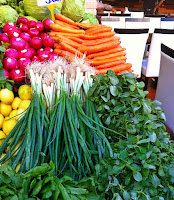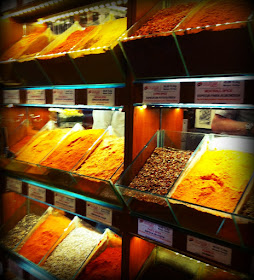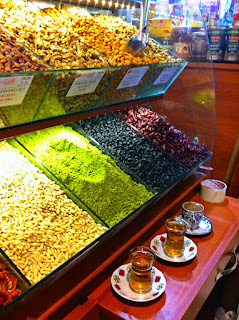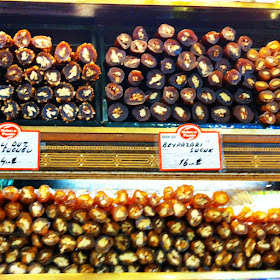Before arriving in Istanbul, we were quite clueless about Turkey's culinary history. Except for the past few weeks in the Balkans, we've never knowingly eaten traditional Turkish or Ottoman cuisine, so we had no idea what to expect. We were pleasantly surprised by all the vegetables in Ottoman cuisine. There are plenty of kebabs to go around, but much of the mezes or small plates are largely vegetable based, with bits of meat only for flavoring. Over the past week, we definitely got our vegetable fix with unlimited amounts of tomatoes, peppers, eggplant, okra, cucumbers, squash, and legumes.
But, we wanted to get the inside scoop on all the goodness at the markets. We figured the best way to learn about a well-developed food culture, steeped in history, was through a guided tour.
We went through Context Travels and booked an Istanbul Markets Tour. It was serendipitous that our first appointment was canceled when our original guide broke her foot. Although we had to re-schedule for a private tour later in the week, we were very happy with our new guide, Aylin Oney Tan. She is a food writer for a Turkish newspaper, food historian, book author, lecturer, and food consultant. She frequently attends food events, was recently consulted to curate a traditional Ottoman wedding feast for a group of journalists, and will be guiding Sara Moulton (one of the original Food Network stars!) through the markets of Istanbul for a television show in a few weeks. She is obviously an expert in Turkish cuisine, and we couldn't believe that she took half a day out of her busy life to take us on a tour (she flew in that morning, just for us, from a mushroom harvesting trip; then was flying out again to some wineries in western Turkey).
Our 4.5 hour tour consisted of going through the Egyptian Spice Bazaar, a ferry ride to the Asia side, markets on the Asia side, lots and lots of tastings along the way, and a tasting menu lunch at the famous Ciya Sofrasi Restaurant to conclude the tour.
EGYPTIAN SPICE BAZAAR
This spice market was created to handle the spice trade coming from Alexandria, Egypt and continuing on into the Balkans, all the way to Venice. Today, it is still the destination spot for locals and tourists to find good quality products.
Our first stop was the most unique food item - bottarga, made from fermented mullet fish roe, dipped in beeswax. It is a delicacy that tastes mildly fishy with a firm but creamy texture. It is sliced very thin and eaten with bread. The store had lots of pictures of Japanese enjoying their product! Yes, Japan...one of the biggest purchasers of fish roe, anywhere in the world.
Next, we visited Ucuzcular Baharat Spice Store that's been in business for 5 generations. They make and sell their own spice blends; dried fruits, vegetables, nuts; hard-to-find traditional 'old-school' seasonings such as from orchid roots and cherry pit seeds; and a variety of tea. We tasted lots and lots of spices - a highlight of our tour. We wished we could buy all of them and take them home. We were served apple tea, a Turkish tradition, while we continued to taste pistachios and dried fruit. We learned that saffron and rose water are a marriage of flavors made in heaven, a complementary pair seen frequently.
We walked by a huge pile of green henna powder that surprisingly turns red when moistened into a liquid. And, a store claiming to have the Sultan's aphrodisiac!
We then walked into Cankurtaran Gida deli selling Turkish cheeses and meats. The best cheese we tasted is called 'sheep's cheese wrapped in goat skin'. See the goat skin/fur below! The Turkish pastrami was also very tasty.
Malatya Pazari is one of the best shops for traditional Turkish sweets, dried fruits, dried vegetables, and nuts. We've never seen dried vegetables strung up. Eggplants, peppers, and squash are hollowed out and hung to dry; later being rehydrated and used as a shell for various stuffings. A huge bundle of dried okra is used to throw into soups and stews. We can't remember the name of the very traditional dessert we tried where a string of walnuts is covered in a starchy coating like dipping a candle. The string is then removed afterwards. It wasn't very sweet, which we liked.
The best Turkish coffee is sold at Kurukahveci Mehmet Efendi where there is a huge long line daily!
MARKETS ON ASIA SIDE
After a short ferry ride across the Bosporus Strait to the Asia side, we continued onto more tastings. We ate a pastry made of tahini or sesame paste. We sampled hard candy and Lokrum or Turkish Delight at the most colorful store ever. We learned that bulgur wheat comes prepared in many sizes and textures. And, the 3 principle herbs in Turkish cooking are flat leaf parsley, dill, and mint.
We really had fun at the pickle store. The sheer volume of brined vine leaves was amazing. It seemed any vegetable was a candidate for pickling, including whole garlic bulbs and unripened melon. Our favorite tasting was the variety of tomato pastes seasoned with chilies that were the most versatile condiment. We shall never look at tomato paste the same again. This store also sold some darn good pomegranate syrup in the consistency and flavors reminiscent of good quality balsamic vinegar.
There was a store making manti, a type of Turkish ravioli filled with meat and served with a yogurt sauce and butter.
CIYA SOFRASI
We finally made it to Chef Musa Dagdeviren's Ciya Sofrasi Restaurant. He has been featured in many internationally acclaimed publications such as Gourmet, New Yorker, Saveur, New York Times, etc. for his high quality traditional Ottoman cuisine. He resurrects old-time home cooked meals of Ottoman past, or forages the country for regional Turkish dishes not found in Istanbul.
We were greeted with 2 refreshing beverages: pomegranate and mulberry juice.
Our tasting menu started with a variety of cold meze: chard in yogurt; dolma; hummus; bulgur salad; Turkish salad; pepper purée; sheep cheese; and an eggplant dish. The condiments included: pomegranate syrup, olive oil, sumac.
Bread oven at Ciya Sofrasi where the puffed up bread and pizza-like flatbread came from.
Next course was the warm mezes: lentils, green beans stir-fry with yogurt sauce; stewed okra with lamb; stuffed grape leaves; meatballs with chickpeas.
The main dish was a lamb and pistachio kebab, accompanied by flatbread, grilled tomato, salad of raw onion, parsley and sumac salad.
The wild thyme tea as a digestive so we can enjoy our dessert!
Dessert was an assortment of preserved or candied items we never imagined could be treated that way and taste good. The young walnut preserved before the shell starts to form was the most interesting item. The preserved olive and tomato were fine, as well as the orange peel. The one thing we couldn't figure out was the candied pumpkin. The outer peel was treated so that it was crunchy like an apple. Not sure how they did that. The center item was a pistachio dessert similar to baklava.
We finally waddled our way back to the ferry terminal, and walked back up the hill to our 'hood to try and work off some of our gluttony. This was a great way to expand our foodie interests in an area we knew nothing about.

























































